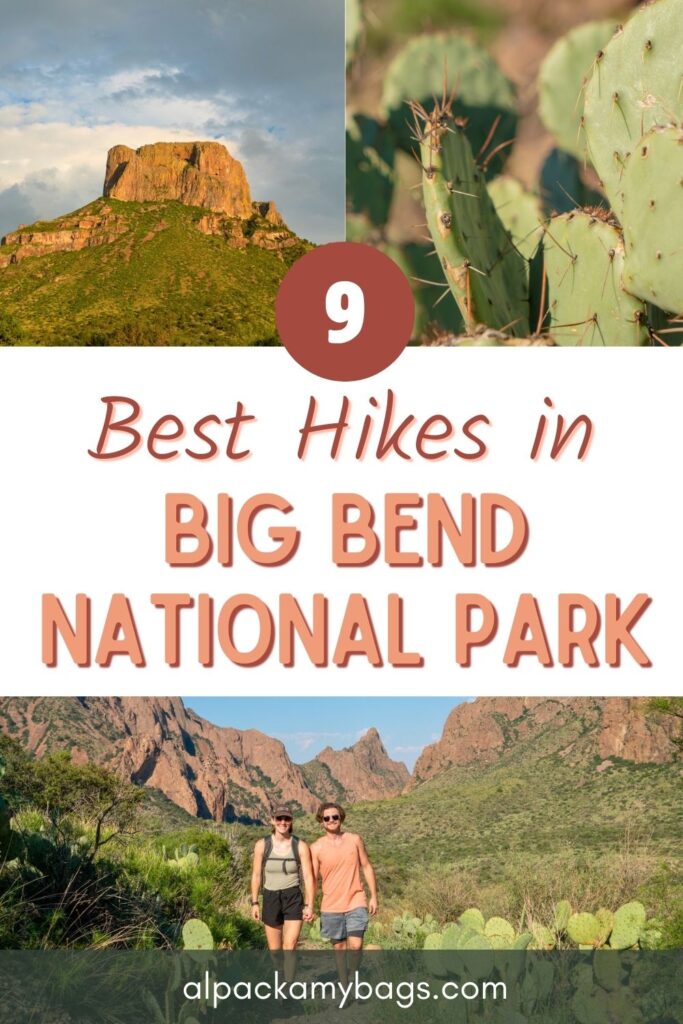
When you think of Texas, you might think of cow pastures, windmills, miles of flat land, and small town after small town. But did you know one of the most underrated US national parks is located in West Texas?
Big Bend National Park is an incredible natural wonder waiting to be explored. If you’re looking for a place to camp, hike, stargaze, and admire wildlife, then Big Bend National Park is the perfect place for you.
Are you ready to experience this gorgeous national park? Below I cover how to get to the park, the best time to visit, the best hikes in Big Bend National Park, the weather, and more. Keep reading to find out how to plan an epic adventure to Big Bend.
Disclosure: This article may contain affiliate links; we get a small commission at no extra cost to you if you make a purchase through one of them. Read our affiliate disclosure.

Visiting Big Bend National Park
To help you plan the best trip possible to Big Bend National Park, here are helpful tips. Learn when the best time to visit is, how to get here, where to stay, and more.
Entrance Fee: Big Bend National Park charges a $30 entrance fee per car; this is valid for 7 days. You can also use your America the Beautiful Pass here, the US national park annual pass.
Open: Year-round; visitor centers operate during normal business hours.
Size: 801,163 acres, more than 150 miles of hiking trails
Wildlife: Black bears, coyotes, tarantulas, snakes, deer, bobcat, mountain lion, javelina, and more
Dog-Friendly: The campsites and paved roads are, but no hiking trails are dog-friendly in Big Bend.
Park Established: June 12, 1944
TIP: If you plan on visiting other national parks like Grand Teton or Shenandoah, then the America the Beautiful annual park pass is worth buying!
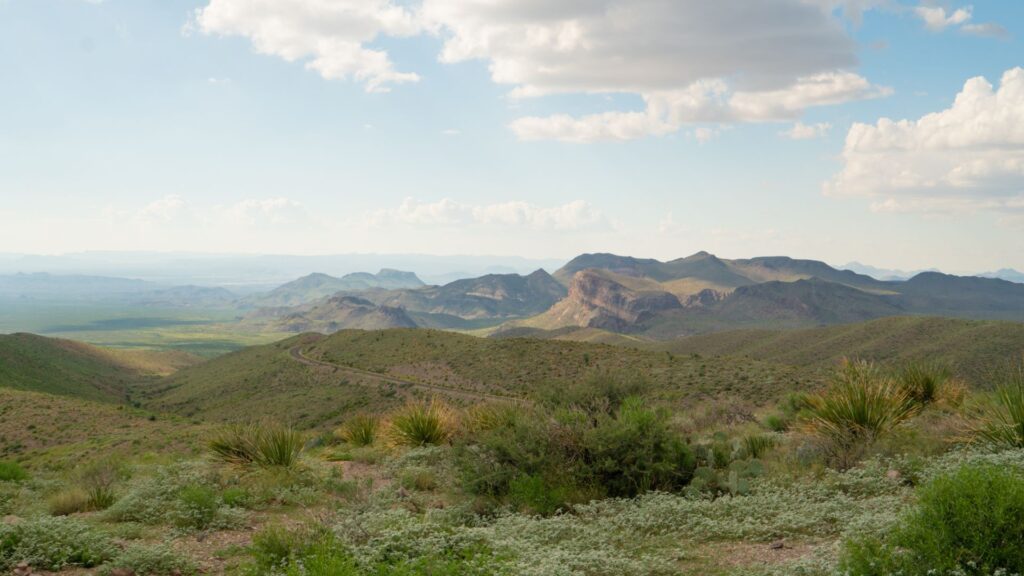
Big Bend National Park Location
So where is Big Bend National Park? This US national park is located in far west Texas, right above the Texas-Mexico border. This area of the US comprises deserts, mountains, and river canyons.
How to Get to Big Bend National Park
Big Bend National Park is located in rural west Texas. You can fly into a “nearby” airport and continue your journey by car, or you can make a road trip out of your visit and drive to Big Bend if you’re coming from somewhere else in the US.
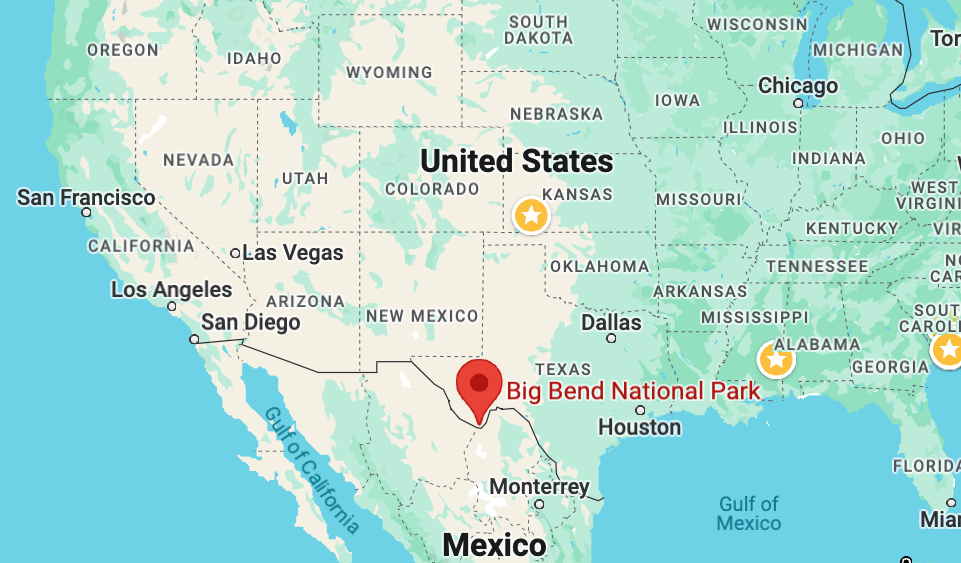
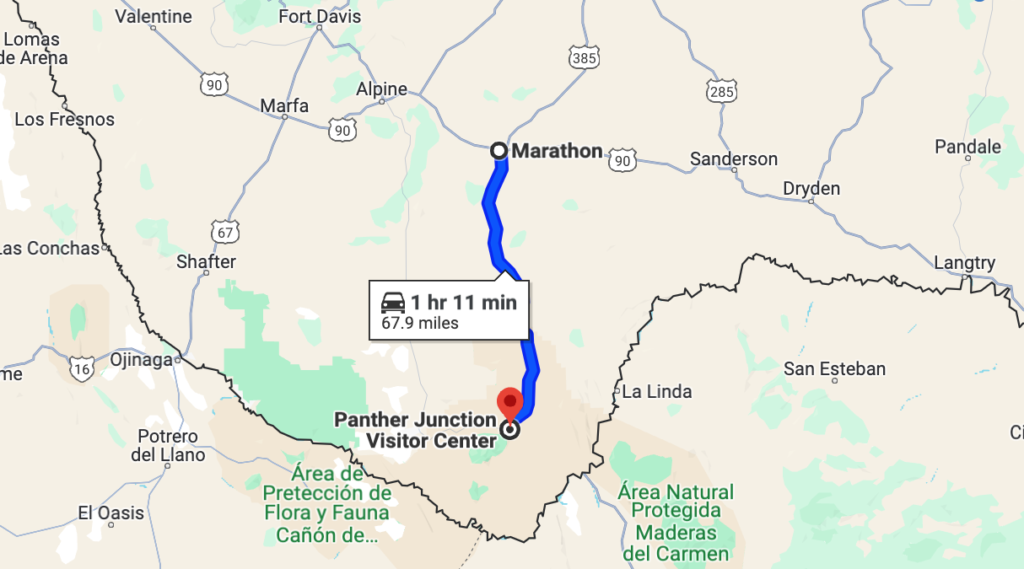
Driving
If you are driving into the park you will drive through Marathon, Texas, the closest town to Big Bend National Park. It is over an hour’s drive from Marathon to Panther Junction Visitor Center in the park.
Big Bend is located in the far south of the Big Bend region of Texas, so the only way to get to the park if you’re driving is from the north. I recommend filling up on gas and snacks, etc. in Marathon at the gas station. There is a gas station in the park, but it’s much more expensive.
Once you’ve entered the park, don’t forget to visit the Panther Junction Visitor Center for maps, trail updates, and fun souvenirs. I couldn’t miss out on adding a national park pin and sticker to my collection!
Flying
If you plan on flying to Big Bend National Park, it is quite a journey, but it’s worth it. There is not an airport near Big Bend National Park; it is situated in a very rural area, far away from any major city.
Below are the closest airports to Big Bend National Park. You will have to rent a car once you land and drive the remainder of the way.
Airports near Big Bend National Park:
Midland International Air & Space Port (MAF) | 196 miles, 3 hours
El Paso International Airport (ELP) | 288 miles, 4 hours and 30 minutes
San Antonio International Airport (SAT) | 374 miles, 5 hours and 40 minutes
Dallas/Fort Worth International Airport (DFW) | 524 miles, 7 hours and 40 minutes
Flying into Dallas (DFW) is the recommended route. It is a much larger airport, so plane tickets will likely be much cheaper to fly into DFW. While this park is out of the way, don’t let it stop you from visiting. We drove 11 hours from east Texas and it was so worth it.

Towns Near Big Bend National Park
The closest towns to Big Bend National Park Panther Junction Visitor Center are Terlingua and Marathon, Texas, about 40 minutes and 1.5 hours drive away, respectively.
This national park is in a very remote area, so make sure you fill up on gas and food before you enter the park.
Towns Closest to Panther Junction Visitor Center in Big Bend National Park:
Terlingua, Texas: 30 miles (40 minutes) west of Panther Junction
Camp Elena (glamping)
Lotus Tents (glamping)
Villa Terlingua
DB’s Rustic Iron BBQ
Marathon, Texas: 68 miles (1 hour and 15 minutes) north of Panther Junction
Eve’s Garden Bed & Breakfast
Gage Hotel
Brick Vault Brewery & Barbecue
There is a gas station at Panther Junction Visitor Center, and they sell basic food necessities. However, it will be much more expensive than buying these things outside of the park.
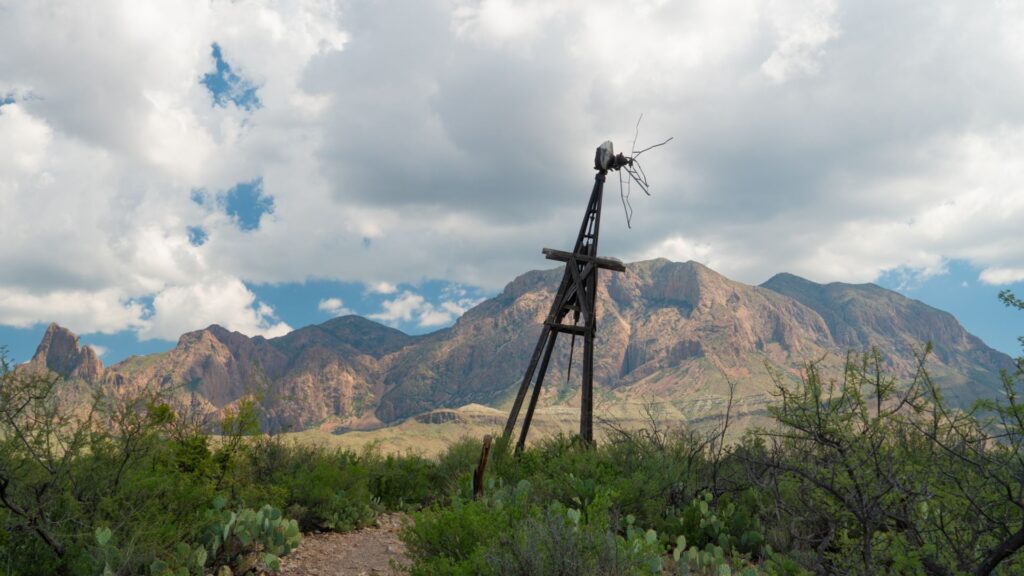
Where to Stay When Visiting Big Bend National Park
There is a lodge as well as four campgrounds in Big Bend National Park. Chisos Mountain Lodge is a great place to stay if you don’t want to camp.
It’s located in a beautiful area, the Chisos Basin, and is surrounded by mountains. The lodge is also very close to several trailheads.
The campgrounds are also great if you want the full nature experience.
Big Bend Lodging: Chisos Mountain Lodge
Chisos Mountain Lodge is a great place to stay in Big Bend National Park. You’ll have the comfort and amenities of a hotel, but the convenience of hiking trails right outside your door.
You could spend your whole time in Big Bend just exploring the Chisos Basin area and still have plenty of hiking to do and views to admire.
The Chisos Mountain Lodge offers lodge rooms as well as five cottages. There is a restaurant on-site as well, and a convenience/grocery store.
I highly recommend dining at the restaurant after a long hike even if you’re not staying at the lodge.
Chisos Mountain Lodge:
Open Year-Round
Restaurant and Store On-Site
Hotel Style Rooms & Cottages
Close to Hiking
Where to Camp in Big Bend National Park

There are a total of four campgrounds in Big Bend National Park, three of which are run by the National Park Service, Chisos Basin, Rio Grande Village, and Cottonwood.
These three campsites all offer drinking water and restroom facilities. However, there are no full RV hook-ups available here.
Rio Grande Village RV Park is run by Aramark, and it has 25 sites with full hookups. This is the only campground with full hook-ups in Big Bend National Park. Thankfully, it’s a good option if you prefer having the hookups.
There is also backcountry camping in Big Bend National Park, which you must obtain a permit for. No matter where you end up camping, always leave your rain cover on your tent. We learned the hard way that it can downpour in Big Bend even if there is no rain forecasted.
Campgrounds in Big Bend National Park:
⭐️ Chisos Basin Campground | Centrally located in the Chisos Mountains, has bathrooms, close to Chisos Basin Lodge and store
Rio Grande Village Campground | Located on the east side of the park, has bathrooms
Cottonwood Campground | Located on the west side of the park, has bathrooms
Rio Grande Village RV Park | Only campground with full hookups
Backcountry Camping | Permits are required for backcountry camping
We stayed at Chisos Basin Campground and loved our stay. The scenery is unbeatable as this campground is surrounded by mountains. I also loved being within walking distance of some of the best hikes in Big Bend National Park.
The central location of Chisos Basin Campground makes it easy to explore any other part of the park. Big Bend National Park is huge, so you’ll end up driving quite a bit, but Chisos Basin’s location makes it a great base.
If you’re camping at an established campground or plan on car camping in Big Bend National Park, prepare for your adventure with the ultimate camping essentials checklist.
Remember there are black bears in Big Bend, so all of your food will need to be stored in your campsite’s bear locker or your car. If you are backcountry camping, do not forget a bear canister.
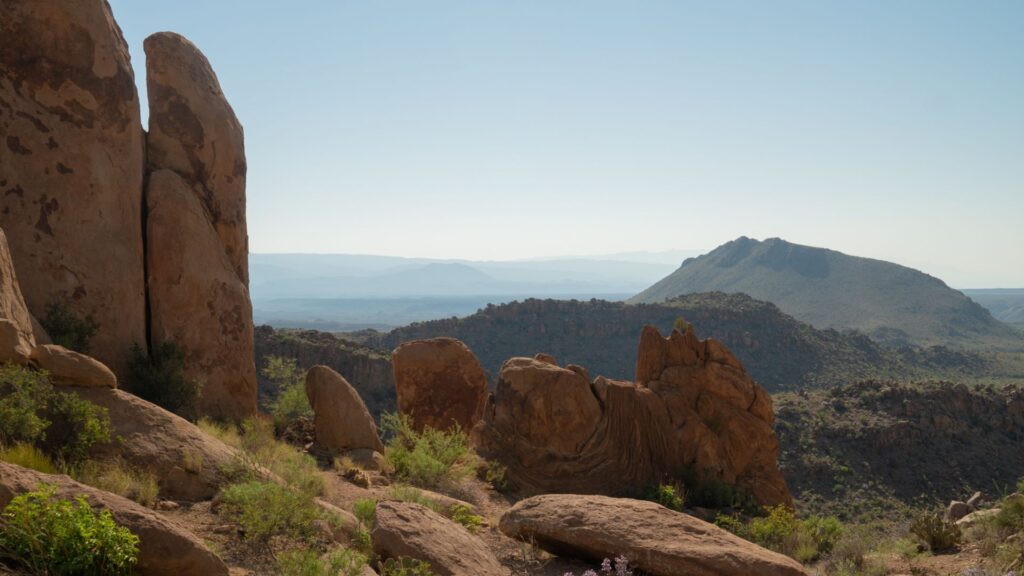
Weather Big Bend National Park
Big Bend National Park is in a dry, desert area. In short, summer in Big Bend is very hot, and not that suitable for hiking. Fall and spring are the best times to visit. It gets warm during the day but cools down nicely at night for the perfect hiking and camping weather.
Big Bend in winter is very cold, as it gets quite windy here. If you bring the proper attire; however, you can comfortably hike and spend time outside during the day in winter.
Summer Weather: June through August
Average High: 87°F
Average Low: 65°F
Fall Weather: September through November
It sometimes rains in Big Bend National Park in the fall, so bring a rain jacket as well. It is usually no more than a drizzle and doesn’t last too long.
Average High: 79°F
Average Low: 46°F
Winter Weather: December through February
If you’re tent camping, you will want a cold-weather sleeping bag. We recommend bringing extra blankets as well.
Average High: 64°F
Average Low: 39°F
Spring Weather: March through May
Bring a rain jacket as well if you visit Big Bend in the spring. It may rain some, but it is generally more of a sprinkle and doesn’t last that long.
Average High: 83°F
Average Low: 48°F
Whatever time of year you plan on visiting Big Bend, just remember there are no tall trees, so there is no shade. Bring plenty of sun protection and water if you plan on hiking during any month.
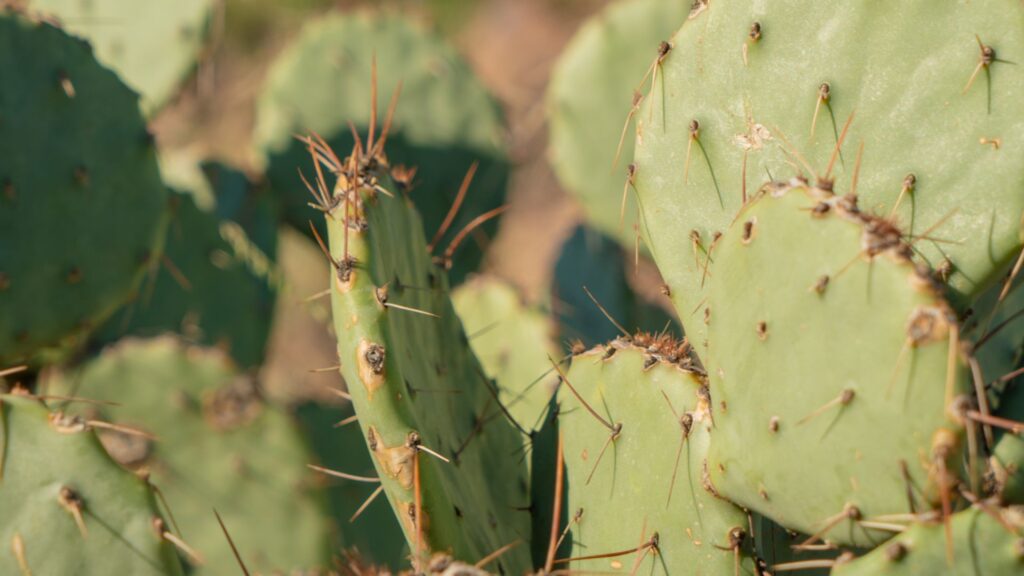
Best Time to Go to Big Bend
The best time of year to visit Big Bend National Park is either fall or spring. These months, April through May and October through November, generally bring cooler weather and smaller crowds.
Enjoy the best hikes in Big Bend the most during spring or fall, and avoid the large crowds and uncomfortable hiking weather that summer and winter bring. It can rain unexpectedly in Big Bend in the spring and fall so a rain jacket would be useful to bring. It is generally a light rain and doesn’t last very long.
Summer tends to be the busiest and the hottest time. Winter can get very cold in Big Bend, but it is still a beautiful time to visit if you bundle up.
Read Next: 5 Best Hikes in Palo Duro Canyon State Park (Texas)

9 Best Hikes in Big Bend National Park
There are many breathtaking Big Bend hiking trails. This national park is a mountain lover’s and desert lover’s paradise alike. The nature and wildlife in Big Bend National Park are incredible.
There are many types of cacti, tarantulas, bears, rivers, the list goes on. If you’re a nature
or hiking lover, you need to visit Big Bend National Park. Always check the NPS website for current hiking conditions and trail closure alerts; i.e. sometimes Santa Elena Canyon is closed due to high water levels.
Before you hit the trails, make sure you have all the day hiking essentials so you can stay safe and have fun. Make the most of your time on the best hikes in Big Bend!
1. Window Trail
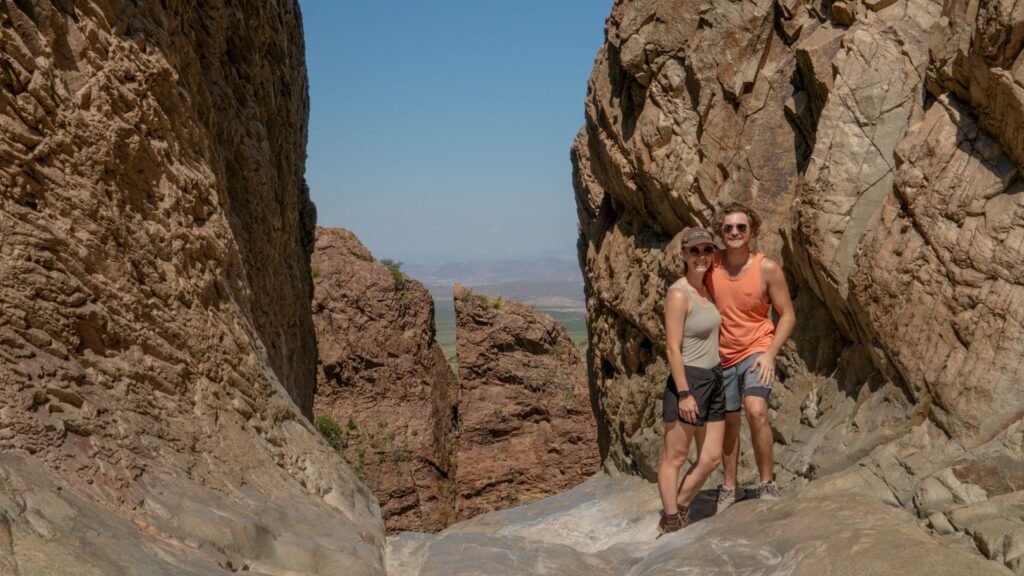
Length: 5.5 miles out & back, 2-3 hours average hiking time
Elevation Gain: 948 feet
Trailhead Location: Chisos Basin Campground
Difficulty: Moderate
Window Trail is my number one recommendation for hiking in Big Bend National Park. You’ll see views of the Chisos Mountains and Basin, tons of pretty plants, possibly wildlife like deer, as well as the “window” view seen in the second photo below.
2. Lost Mine Trail

Length: 4.8 miles out & back, 3-hour average hiking time
Elevation Gain: 1,131 feet
Trailhead Location: Mile marker 5 off Chisos Basin Road
Difficulty: Moderate
This trail offers some beautiful sweeping mountain views, but it can often be cloudy and foggy. This might affect your visibility and make the trail muddy, so keep this in mind and check the weather before you head out.
3. Balanced Rock

Length: 2-mile out & back, 50-minute average hiking time
Elevation Gain: 246 feet
Trailhead Location: Grapevine Hills Trailhead; high clearance vehicle required
Difficulty: Easy until the last quarter mile “climb” up to the rock
Balanced rock is quite literally a giant rock balancing on two others, and it’s worth the hike. The scenery on the way up and once you’re at the top are gorgeous. You can see the valley from above (first picture below). This is a good trail for a picnic!
4. Santa Elena Canyon

Length: 1.4-mile out & back, 40-minute average hiking time
Elevation Gain: 209 feet
Trailhead Location: Santa Elena Canyon Trailhead
Difficulty: Varying conditions depending on water levels (flooding is common)
Santa Elena Canyon is one of Big Bend’s most popular places. The view of the canyon is gorgeous on the hike, but it can get muddy so wear hiking boots and be prepared to possibly get a little wet.
5. Ross Maxwell Scenic Drive

Length: 30.9-mile point-to-point paved road
Location: Starts at the intersection of Panther Junction Road and Ross Maxwell Scenic Drive
Notes: Popular for biking and driving, with various trailheads and overlooks along the way
If you’re only in Big Bend for a day or two, I highly recommend hopping on the Ross Maxwell Scenic Drive. You can easily tack on a couple of shorter hikes along the way; Upper Burro Mesa Pour-Off and Sam Nail Ranch Trail are both off Ross Maxwell Scenic Drive.
6. Upper Burro Mesa Pouroff
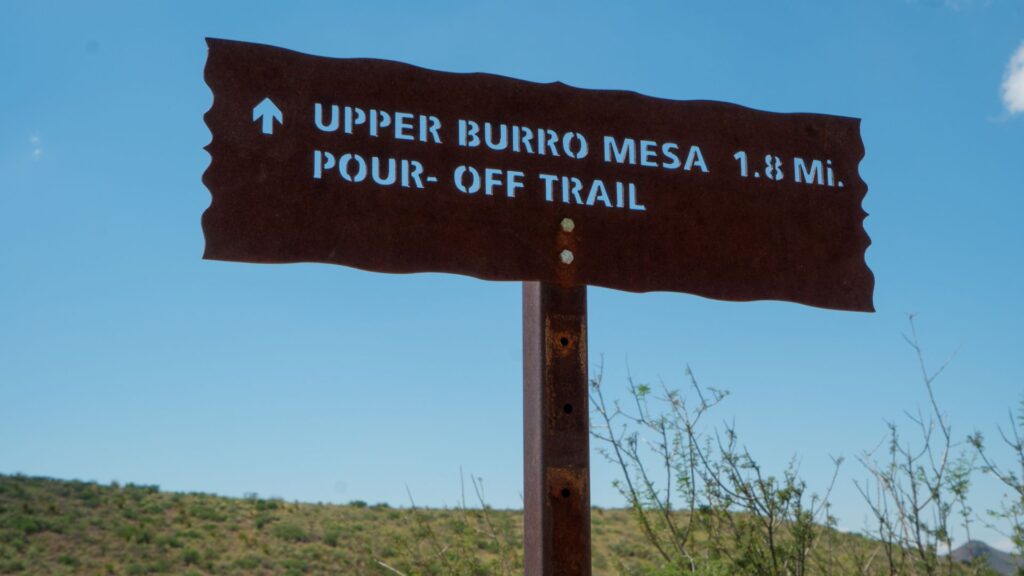
Length: 3.5-mile out & back, 1.5 hours average hiking time
Elevation Gain: 459 feet
Trailhead Location: Upper Burro Mesa Pouroff Trailhead off Ross Maxwell Scenic Dr.
Difficulty: Moderate
Even if you don’t hike the entire Upper Burro Mesa Pouroff Trail, the scenery and wildlife you’ll see make it worth it. You’ll walk through a canyon most of the way, and there are a few great spots to stop for views (and photos!).
7. Laguna Meadow Trail

Length: 7.8-mile out & back, 4 hours average hiking time
Elevation Gain: 1,755 feet
Trailhead Location: Chisos Basin Visitor Center
Difficulty: Moderate
Laguna Meadow Trail is in the Chisos Basin which is one of the prettiest parts of Big Bend National Park. You’ll start near the Chisos Basin Visitor Center. This trail can get steep, there are switchbacks, so bring plenty of water (around 1 liter per hour).
8. Sam Nail Ranch Trail
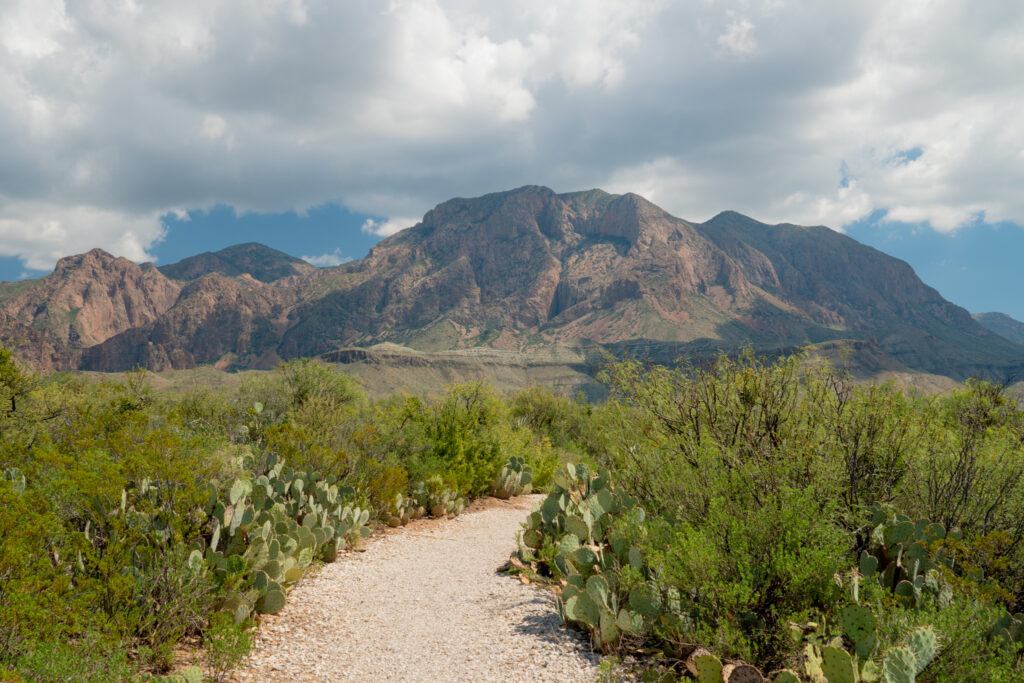
Length: 0.3-mile loop, 10-minute average hiking time
Elevation Gain: 29 feet
Trailhead Location: Sam Nail Ranch off Ross Maxwell Scenic Dr.
Difficulty: Easy
Sam Nail Ranch is a 1900s ranching area. You can see the remains of the two-room home that Sam Nail built and lived in with his family in the early 1900s. There is also an original windmill you can see that was used to pump water from the ground. Don’t forget to admire the view of the Chisos Mountains on this trail (pictured below).
9. Mule Ear Spring Trail
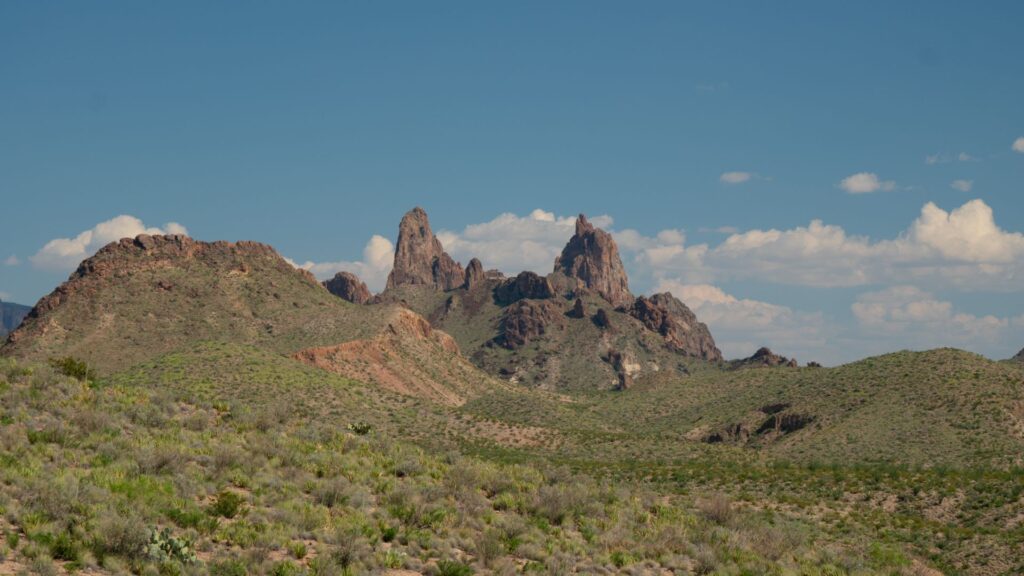
Length: 3.9 miles out & back, 1 hour and 30 minutes average hiking time
Elevation Gain: 410 feet
Trailhead Location: Mule Ears Viewpoint on Mule Ears Road
Difficulty: Moderate
Two mountain peaks form what’s known as the “mule ears” pictured below because they look like just that. You can stop at the pullout and enjoy the view from afar, or hike the Mule Ear Spring Trail for a closer look and a nice hike.
Best Hikes in Big Bend National Park FAQ:

If you enjoy hiking, plan a trip to these US national parks for an adventurous getaway! Check out New River Gorge, Grand Teton, Congaree, Hot Springs, and Shenandoah National Parks.
What is the most scenic trail in Big Bend?
Big Bend National Park has no shortage of beautiful scenery. However, the two most scenic trails in Big Bend are Window Trail and Sam Nail Ranch Trail.
Window Trail is a 5.5-mile out & back that begins at Chisos Basin Campground. On this trail, you can admire the Chisos Mountains, tons of wildlife, and a very pretty view from the “window” in the mountain.
Sam Nail Ranch Trail is a 0.3-mile loop and very flat, so it’s a nice, easy scenic trail. From here you’ll see a wide view of the Chisos Mountains making a beautiful backdrop.
What is the best scenic route in Big Bend National Park?
The Ross Maxwell Scenic Drive is the best scenic route in Big Bend National Park. It’s about 31 miles long and is popular for driving and biking. There are many trailheads and overlooks along Ross Maxwell Scenic Drive that you can pull off to enjoy.
Some of the best hikes are Sam Nail Ranch Trail and Upper Burro Mesa Pour-Off. A few of the best overlooks on the Ross Maxwell Scenic Drive are Sotol Vista Overlook and Mule Ears Viewpoint.
Which part of Big Bend is best?
The Chisos Mountain Basin is a great place to base yourself when visiting Big Bend National Park. It is located in the center of the park and you can camp here or stay in the Chisos Basin Lodge.
Many of the best hikes start in or near Chisos Basin including Window Trail and Laguna Meadow Trail. The mountain basin is the most scenic part of Big Bend as well.
How do you enter Big Bend National Park?
Big Bend National Park has two entrances, one on the west side and one on the north end.
If you’re entering from Terlingua, the west, you’ll drive down the 118 until it turns into Panther Junction Road.
If you’re driving from Marathon, the north, you’ll enter on the 385 that turns into Main Park Road.
Both entrances are about 30 minutes from Panther Junction Visitor Center which is centrally located in the park.
Do you need a car in Big Bend National Park?
A car is required to visit Big Bend National Park. The closest towns are miles away; Marathon, Texas is over an hour away.
There are no shuttles in the park either, and being such a large park, trailheads are often far away from one another.
You will likely have to drive several hours from the airport you decide to fly into, so you will need to rent a car to get to Big Bend National Park anyways.
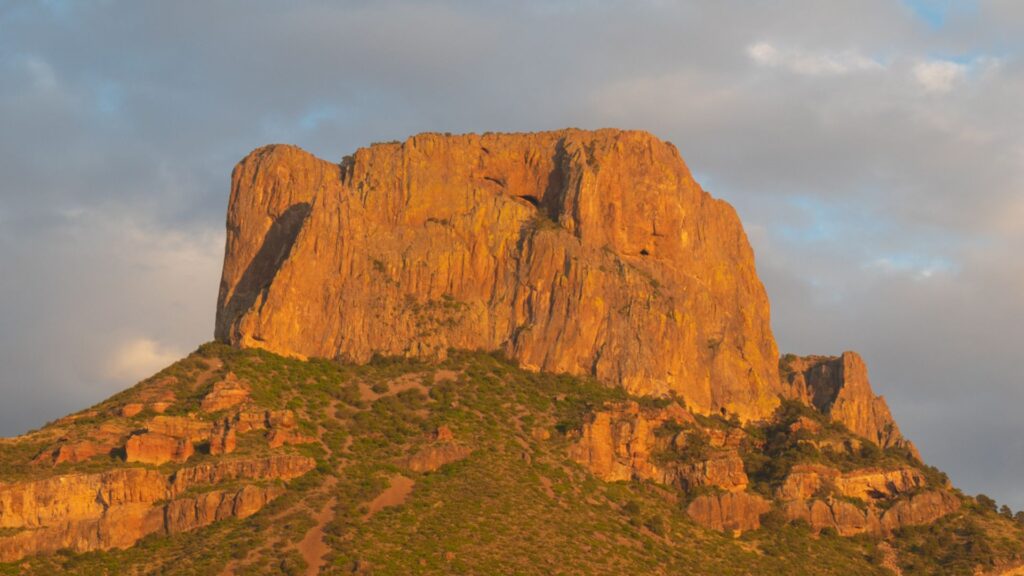
What to Bring to Big Bend National Park
Chances are you will be hiking when you visit Big Bend, National Park. This is a desert, so having proper attire is very important and it depends on the season. However, the following are necessary items to bring regardless of the season.
If you plan on camping and hiking, here’s what to bring to Big Bend National Park:
Backpack: small day hiking backpack
Hiking boots: women’s boots & men’s boots
Hiking Socks: recommended pair
Athletic shirts: sweat-wicking or merino wool are best for hiking
Reusable water bottle: recommended brand
Snacks for hiking: the best snack bars
Food + cookware: camping essentials
Bear Safety: bear spray, bear canister, & odor-free bags
Sweater or jacket: multiple layers are a must in the desert
Sunscreen: a travel bottle of sunscreen is easy to carry in your backpack
Bug Repellent: especially necessary in warmer weather (natural bug spray)
Tent + rain cover: don’t forget your rain cover
Sleeping bag + pillow: cold weather sleeping bag is best
Lantern: larger lantern and smaller, more compact lantern
Camera: your phone or this recommended Sony

If you plan on visiting Big Bend in winter or during the cooler months, you should also pack a warm coat or heavy jacket, thermal pants, thicker socks, a beanie, and gloves if you run cold. Read more on camping in winter.
During the late spring, summer, and early fall, you will also want to bring a rain jacket and an umbrella. It tends to rain very randomly in Big Bend. There might be no rain forecasted at all, but it can still suddenly downpour. This is why you also need a rain cover for your tent!
View a full list of camping essentials and what to bring on a day hike for more details on what to bring to Big Bend National Park.

With all the details on hand, you are now ready to visit Big Bend National Park! You know where it is located, what the weather is like, where to stay, and more. Now pack your bags, bring your hiking boots, and get ready for the adventure of a lifetime!
The best hikes in Big Bend National Park are some of the most scenic trails in the southern US. Texas is hiding this hard-to-get-to-but-so-worth-it nature gem, it’s time to hit the trails and explore it.
Find out for yourself why one of America’s most underrated national parks is so worth visiting. Reminder: it has something to do with the incredible wildlife, mountains, and hiking. Desert mountains are an incredible sight to admire!
When will you be heading to Big Bend National Park? Let us know in the comments below!

